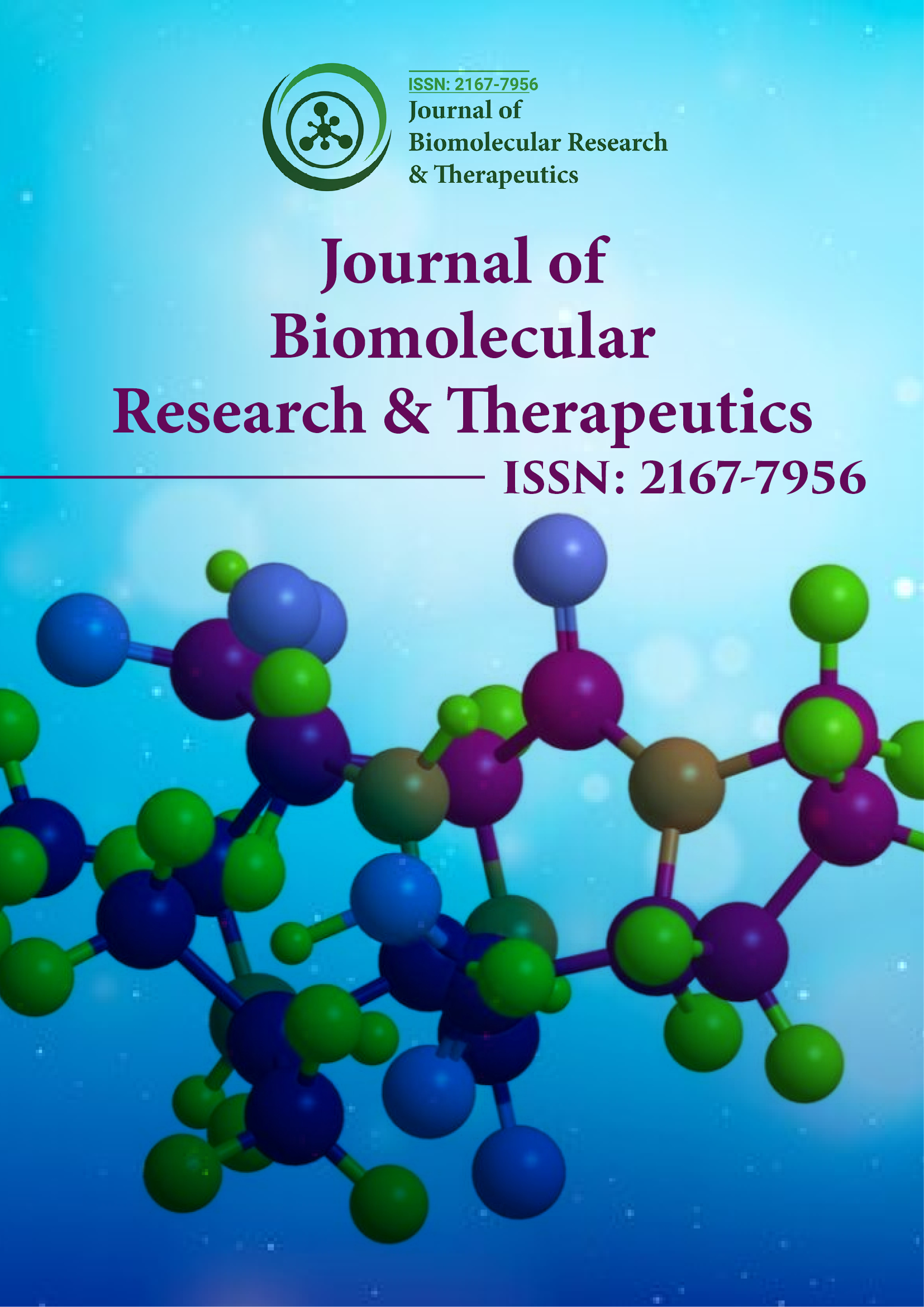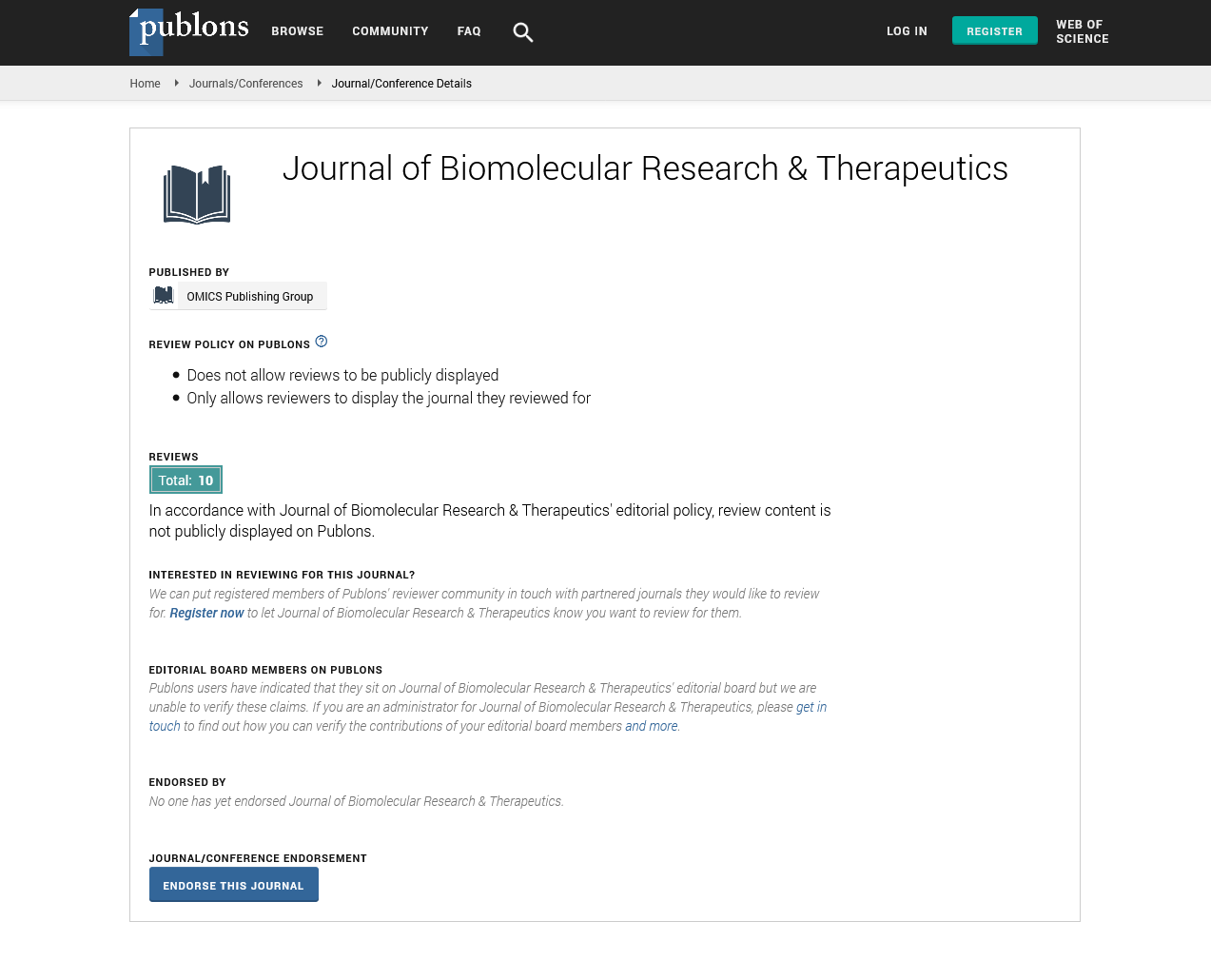Indexed In
- Open J Gate
- Genamics JournalSeek
- ResearchBible
- Electronic Journals Library
- RefSeek
- Hamdard University
- EBSCO A-Z
- OCLC- WorldCat
- SWB online catalog
- Virtual Library of Biology (vifabio)
- Publons
- Euro Pub
- Google Scholar
Useful Links
Share This Page
Journal Flyer

Open Access Journals
- Agri and Aquaculture
- Biochemistry
- Bioinformatics & Systems Biology
- Business & Management
- Chemistry
- Clinical Sciences
- Engineering
- Food & Nutrition
- General Science
- Genetics & Molecular Biology
- Immunology & Microbiology
- Medical Sciences
- Neuroscience & Psychology
- Nursing & Health Care
- Pharmaceutical Sciences
Opinion Article - (2025) Volume 14, Issue 1
Allosteric Stabilization of p53 by Novel Small Molecules: Biochemical Characterization and In Vivo Efficacy
Oliver Grant*Received: 27-Jan-2025, Manuscript No. BOM-25-29311; Editor assigned: 29-Jan-2025, Pre QC No. BOM-25-29311; Reviewed: 12-Feb-2025, QC No. BOM-25-29311; Revised: 18-Feb-2025, Manuscript No. BOM-25-29311; Published: 26-Feb-2025, DOI: 10.35248/2167-7956.25.14.419
Description
The tumor suppressor protein p53, often dubbed the “guardian of the genome,” plays a vital role in maintaining cellular homeostasis by regulating DNA repair, apoptosis, senescence AND cell cycle arrest in response to genotoxic stress. Under normal physiological conditions, p53 remains at low levels due to its rapid degradation, primarily mediated by the E3 ubiquitin ligase MDM2. However, upon cellular stress or DNA damage, p53 is stabilized and activated, leading to transcriptional activation of numerous target genes involved in tumor suppression. Despite its central role in protecting against oncogenesis, p53 function is lost or mutated in over 50 % of human cancers, making it one of the most frequently altered genes in malignancy. Even in tumors with wild-type p53, its activity is often suppressed through overexpression of negative regulators like MDM2 or MDMX. As such, restoring or enhancing p53 activity has emerged as a promising therapeutic approach in oncology. While several MDM2 inhibitors are under investigation, allosteric modulation of p53 presents an innovative strategy to restore its tumor suppressive functions without directly interfering with the MDM2-p53 interface. In this study, we describe the design, biochemical characterization AND in vivo evaluation of a new class of small molecules that allosterically stabilize wild-type p53 and reactivate its function in cancer cells. Unlike orthosteric inhibitors that target the primary MDM2 binding site, our compounds bind to a previously underexplored allosteric pocket located within the DNA-Binding Domain (DBD) of p53. The rationale for targeting this domain lies in the fact that many cancer-associated p53 mutations cluster within the DBD, destabilizing its structure and impairing its transcriptional activity. Stabilizing this domain could potentially rescue the function of not only wild-type p53 but also some mutant variants with partial residual activity.
A High-Throughput Screening (HTS) campaign of over 50,000 compounds was conducted using a fluorescence-based thermal shift assay to identify small molecules that increase the thermal stability of recombinant p53-DBD. Initial hits were validated through Isothermal Titration Calorimetry (ITC), Surface Plasmon Resonance (SPR) AND Nuclear Magnetic Resonance (NMR) spectroscopy to confirm direct binding and determine binding kinetics. Among the top candidates, compound ALP-46 emerged as a potent allosteric stabilizer, increasing the melting temperature of the DBD by over 10 °C and demonstrating a dissociation constant of 120 NM. Computational docking studies and molecular dynamics simulations suggested that ALP-46 interacts with a hydrophobic groove adjacent to the β- sandwich core, inducing a conformational shift that locks the DBD into its active conformation. Biochemical assays confirmed that ALP-46 enhances the DNA-binding affinity of p53 to consensus response elements, as measured by Electrophoretic Mobility Shift Assays (EMSA) and Chromatin Immunoprecipitation (ChIP). In cell-based assays using p53 wildtype cancer cell lines (e.g., HCT116, A549), treatment with ALP-46 led to a robust increase in p53 protein levels and transcriptional activation of target genes such as CDKN1A (p21), BAX AND PUMA. Western blotting and qRT-PCR analyses further confirmed the upregulation of p53 target proteins and mRNA expression, respectively. Importantly, ALP-46 had minimal effect in p53-null or mutant cell lines, suggesting specificity for functional p53 pathways.
Functionally, ALP-46 treatment induced cell cycle arrest in G1 phase, reduced colony formation AND triggered apoptosis as evidenced by increased caspase-3 activation and annexin V staining. These effects were abrogated by siRNA-mediated knockdown of p53, confirming that the antiproliferative activity of ALP-46 is p53-dependent. Compared to established MDM2 inhibitors like Nutlin-3a, ALP-46 showed a broader therapeutic window and lower off-target toxicity in non-cancerous cell lines such as human fibroblasts and epithelial cells. To assess in vivo efficacy, we evaluated ALP-46 in two xenograft models: a subcutaneous HCT116 tumor model and an orthotopic lung cancer model using A549 cells. Mice were treated with ALP-46 (25 mg/kg, intraperitoneally) three times per week for four weeks. In both models, ALP-46 significantly reduced tumor volume and weight compared to vehicle-treated controls, with no observed toxicity or weight loss. Immunohistochemistry of excised tumors revealed increased nuclear p53 localization, elevated p21 expression AND higher levels of apoptotic markers such as cleaved PARP and TUNEL staining. Pharmacokinetic profiling showed that ALP-46 has favorable bioavailability, a halflife of 7 hours AND good tissue distribution, including accumulation in tumor tissue.
To further elucidate the mechanism of action, RNA sequencing (RNA-seq) was performed on treated tumors. Gene expression analysis indicated a broad activation of p53-regulated transcriptional networks, particularly those involved in apoptosis, senescence AND DNA repair. Pathway enrichment analysis highlighted upregulation of p53 signaling, cell cycle checkpoint control AND intrinsic apoptotic signaling, supporting the hypothesis that ALP-46 reactivates the tumorsuppressive functions of p53 in vivo. Notably, there was no evidence of systemic immune activation or hepatotoxicity, as determined by serum cytokine panels and liver enzyme levels. In conclusion, this study demonstrates that allosteric stabilization of p53 using small molecules such as ALP-46 is a viable strategy for restoring p53 function in cancers that retain the wild-type form of the protein. By targeting a novel regulatory site within the DNA-binding domain, ALP-46 avoids the limitations of MDM2 antagonists and achieves selective reactivation of p53 with minimal toxicity. The compound’s ability to induce tumor regression, activate p53 transcriptional programs AND display favorable pharmacokinetics makes it a strong candidate for further preclinical development. Future studies will focus on evaluating the efficacy of ALP-46 in combination with DNAdamaging chemotherapies and assessing its activity in tumors harboring partially functional p53 mutants. This work contributes significantly to the growing body of literature exploring non-canonical strategies to pharmacologically reactivate tumor suppressors in cancer therapy.
Citation: Grant O (2025) Allosteric Stabilization of p53 by Novel Small Molecules: Biochemical Characterization and In Vivo Efficacy. J Biol Res Ther. 14:419.
Copyright: © 2025 Grant O. This is an open access article distributed under the terms of the Creative Commons Attribution License, which permits unrestricted use, distribution AND reproduction in any medium, provided the original author and source are credited.

